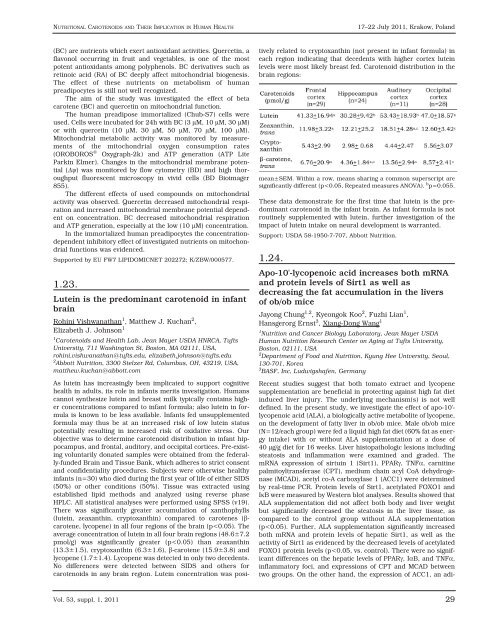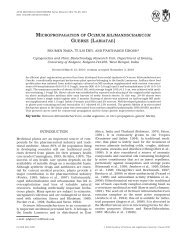ACTA BIOLOGICA CRACOVIENSIA
ACTA BIOLOGICA CRACOVIENSIA
ACTA BIOLOGICA CRACOVIENSIA
You also want an ePaper? Increase the reach of your titles
YUMPU automatically turns print PDFs into web optimized ePapers that Google loves.
NUTRITIONAL CAROTENOIDS AND THEIR IMPLICATION IN HUMAN HEALTH<br />
(BC) are nutrients which exert antioxidant activities. Quercetin, a<br />
flavonol occurring in fruit and vegetables, is one of the most<br />
potent antioxidants among polyphenols. BC derivatives such as<br />
retinoic acid (RA) of BC deeply affect mitochondrial biogenesis.<br />
The effect of these nutrients on metabolism of human<br />
preadipocytes is still not well recognized.<br />
The aim of the study was investigated the effect of beta<br />
carotene (BC) and quercetin on mitochondrial function.<br />
The human preadipose immortalized (Chub-S7) cells were<br />
used. Cells were incubated for 24h with BC (3 μM, 10 μM, 30 μM)<br />
or with quercetin (10 μM, 30 μM, 50 μM, 70 μM, 100 μM).<br />
Mitochondrial metabolic activity was monitored by measurements<br />
of the mitochondrial oxygen consumption rates<br />
(OROBOROS ® Oxygraph-2k) and ATP generation (ATP Lite<br />
Parkin Elmer). Changes in the mitochondrial membrane potential<br />
(Δψ) was monitored by flow cytometry (BD) and high thoroughput<br />
fluorescent microscopy in vivid cells (BD Bioimager<br />
855).<br />
The different effects of used compounds on mitochondrial<br />
activity was observed. Quercetin decreased mitochondrial respiration<br />
and increased mitochondrial membrane potential dependent<br />
on concentration. BC decreased mitochondrial respiration<br />
and ATP generation, especially at the low (10 μM) concentration.<br />
In the immortalized human preadipocytes the concentrationdependent<br />
inhibitory effect of investigated nutrients on mitochondrial<br />
functions was evidenced.<br />
Supported by EU FW7 LIPIDOMICNET 202272; K/ZBW/000577.<br />
1.23.<br />
Lutein is the predominant carotenoid in infant<br />
brain<br />
Rohini Vishwanathan1 , Matthew J. Kuchan2 ,<br />
Elizabeth J. Johnson 1<br />
1Carotenoids and Health Lab, Jean Mayer USDA HNRCA, Tufts<br />
University, 711 Washington St, Boston, MA 02111, USA,<br />
rohini.vishwanathan@tufts.edu, elizabeth.johnson@tufts.edu<br />
2Abbott Nutrition, 3300 Stelzer Rd, Columbus, OH, 43219, USA,<br />
matthew.kuchan@abbott.com<br />
As lutein has increasingly been implicated to support cognitive<br />
health in adults, its role in infants merits investigation. Humans<br />
cannot synthesize lutein and breast milk typically contains higher<br />
concentrations compared to infant formula; also lutein in formula<br />
is known to be less available. Infants fed unsupplemented<br />
formula may thus be at an increased risk of low lutein status<br />
potentially resulting in increased risk of oxidative stress. Our<br />
objective was to determine carotenoid distribution in infant hippocampus,<br />
and frontal, auditory, and occipital cortices. Pre-existing<br />
voluntarily donated samples were obtained from the federally-funded<br />
Brain and Tissue Bank, which adheres to strict consent<br />
and confidentiality procedures. Subjects were otherwise healthy<br />
infants (n=30) who died during the first year of life of either SIDS<br />
(50%) or other conditions (50%). Tissue was extracted using<br />
established lipid methods and analyzed using reverse phase<br />
HPLC. All statistical analyses were performed using SPSS (v19).<br />
There was significantly greater accumulation of xanthophylls<br />
(lutein, zeaxanthin, cryptoxanthin) compared to carotenes (βcarotene,<br />
lycopene) in all four regions of the brain (p












